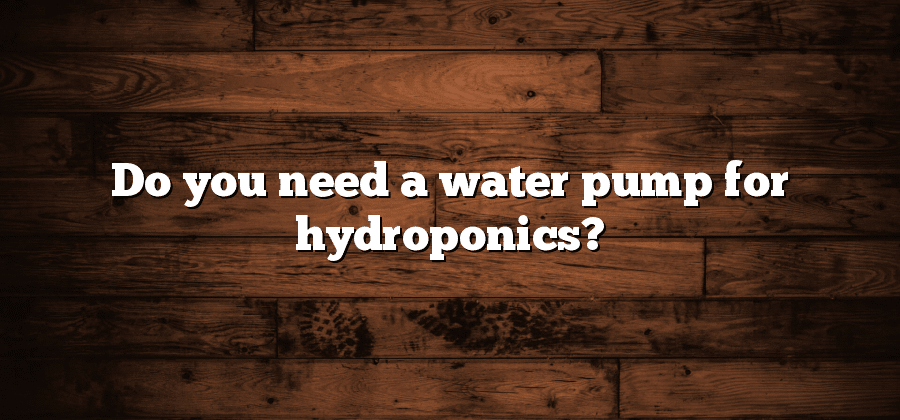Understanding the Importance of Water Circulation
Water circulation is a crucial factor to consider in any hydroponic system. Without proper circulation, the water becomes stagnant, leading to a multitude of problems that can negatively impact plant growth and overall system performance. One of the key reasons why water circulation is important is that it helps to distribute oxygen and nutrients evenly to the plant roots. In a hydroponic setup, plants are grown in a nutrient-rich solution rather than soil. Therefore, it is vital to ensure that the nutrients are effectively delivered to the roots for optimal absorption and growth. Without proper circulation, the nutrients can settle at the bottom, leading to nutrient deficiencies in some areas and excess in others.
Additionally, water circulation plays a significant role in preventing the proliferation of harmful pathogens and algae. Stagnant water provides an ideal environment for the growth of various microorganisms that can harm plants. By keeping the water moving, the risk of root rot, bacterial infections, and other diseases is greatly reduced. Moreover, constant water movement helps to discourage the growth of algae, which can compete with the plants for nutrients and light. By maintaining a healthy water circulation, growers can ensure a clean and disease-free environment for their hydroponic plants, promoting their overall health and productivity.
Exploring the Role of Water Pump in Hydroponics
Water pumps play a crucial role in hydroponics systems, providing the necessary movement and circulation of water to ensure optimal plant growth. Unlike traditional soil-based gardening, hydroponics relies on nutrient-rich water solutions to deliver essential elements directly to the plant roots. In this context, water pumps act as the driving force behind this delivery process, ensuring that the nutrients are evenly distributed and absorbed by the plants.
One of the key functions of the water pump is to maintain a continuous flow of water throughout the system. By circulating the water, the pump helps to prevent stagnant conditions that can lead to the buildup of harmful bacteria and algae. In addition, the constant movement of the water helps to oxygenate the nutrient solution, providing a vital element for plant respiration. Therefore, the water pump not only ensures the delivery of nutrients but also helps to create an optimal growing environment for the plants in hydroponic systems.
Differentiating Between Passive and Active Hydroponic Systems
Passive and active hydroponic systems are two distinct approaches to growing plants without the use of soil. While both methods involve the delivery of water and nutrients directly to the plant roots, there are crucial differences in how they achieve this.
Passive hydroponic systems, as the name suggests, rely on a less hands-on approach. These systems use a wicking material, such as coconut coir or perlite, to draw water and nutrients to the plant roots. The wicking material acts like a sponge, soaking up water from a reservoir and delivering it to the roots as needed. This method is simple and low-maintenance, making it ideal for beginners or those looking for a more hands-off approach to hydroponics. However, the downside of passive systems is that they can be less precise in delivering nutrients, as the wicking material can become saturated or clogged over time.
Optimizing Nutrient Absorption through Water Movement
To optimize nutrient absorption in hydroponic systems, it is crucial to understand the role of water movement. Water movement plays a vital role in delivering essential nutrients to the plant roots, ensuring their proper uptake and utilization. Without adequate water movement, the nutrients in the solution can become stagnant, leading to nutrient deficiencies and impeding plant growth.
One way to enhance water movement is by using water pumps in hydroponics. These pumps create a continuous flow of nutrient solution, preventing the buildup of stagnant water and ensuring a constant supply of nutrients to the roots. The movement created by the water pumps also helps to oxygenate the solution, promoting healthy root development and preventing the growth of harmful pathogens. Overall, optimizing nutrient absorption through water movement is essential for maximizing the growth and productivity of plants in a hydroponic system.
Enhancing Oxygenation in Hydroponic Systems with Water Pumps
Hydroponic systems have revolutionized the way plants are grown, allowing for maximum efficiency and yields. One crucial aspect of these systems is the oxygenation of the nutrient solution, which is essential for the plants’ growth and overall health. This is where water pumps play a vital role.
Water pumps in hydroponic systems serve as the driving force behind the oxygenation process. By circulating the nutrient solution, they ensure that the water is constantly in motion, allowing for enhanced oxygen absorption by the plant roots. This is particularly important in systems that don’t rely on soil, as the oxygen supply in the root zone is not as readily available. The continuous movement of the water helps to prevent stagnation and ensures that the roots receive a constant supply of oxygen, promoting robust and healthy plant growth.






